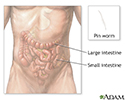Pinworms
Enterobiasis; Oxyuriasis; Threadworm; Seatworm; Enterobius vermicularis; E vermicularis; Helminthic infectionPinworms are small worms that infect the intestines.
Causes
Pinworms are the most common worm infection in the United States. School-age children are most often affected.
Pinworm eggs are spread directly from person to person. They can also be spread by touching bedding, food, or other items that are contaminated with the eggs.
Typically, children are infected by touching pinworm eggs without knowing it and then putting their fingers in their mouth. They swallow the eggs, which eventually hatch in the small intestine. The worms mature in the colon.
Female worms then move to the child's anal area, especially at night, and deposit more eggs. This may cause intense itching. The area may even become infected. When the child scratches the anal area, the eggs can get under the child's fingernails. These eggs can be transferred to other children, family members, and items in the house.
Symptoms
Symptoms of pinworm infection include:
- Difficulty sleeping due to the itching that occurs during the night
- Intense itching around the anus
- Irritability due to itching and interrupted sleep
- Irritated or infected skin around the anus, from constant scratching
- Irritation or discomfort of the vagina in young girls (if an adult worm enters the vagina rather than the anus)
- Loss of appetite and weight (uncommon, but can occur in severe infections)
Exams and Tests
Pinworms (one-fourth to one-half inches long) can be spotted in the anal area, mainly at night when the worms lay their eggs there.
Your health care provider may have you do a tape test. A piece of cellophane tape is pressed against the skin around the anus, and removed. This should be done in the morning before bathing or using the toilet, because bathing and wiping may remove eggs. The provider will stick the tape to a slide and look for eggs using a microscope.
Tape test
A pinworm test is a method used to identify a pinworm infection. Pinworms are small, thin worms that commonly infect young children, although anyone...

Treatment
Anti-worm medicines are used to kill the pinworms (not their eggs). Your provider will likely recommend one dose of medicine that is available over-the-counter and by prescription.
More than one household member is likely to be infected, so the entire household is often treated. Another dose is usually repeated after 2 weeks. This treats worms that hatched since the first treatment.
To control the eggs:
- Clean toilet seats daily
- Keep fingernails short and clean
- Wash all bed linens twice a week
- Wash hands before meals and after using the toilet
Avoid scratching the infected area around the anus. This can contaminate your fingers and everything else that you touch.
Keep your hands and fingers away from your nose and mouth unless they are freshly washed. Be extra careful while family members are being treated for pinworms.
Outlook (Prognosis)
Pinworm infection is fully treatable with anti-worm medicine.
When to Contact a Medical Professional
Contact your provider for an appointment if:
- You or your child has symptoms of pinworm infection
- You have seen pinworms on your child
Prevention
Wash hands after using the bathroom and before preparing food. Wash bedding and underclothing frequently, particularly those of any affected family members.
References
Dobbs KR, Dent AE. Enterobiasis (Enterobius vermicularis). In: Kliegman RM, St Geme JW, Blum NJ, et al, eds. Nelson Textbook of Pediatrics. 22nd ed. Philadelphia, PA: Elsevier; 2025:chap 340.
Hotez PJ. Parasitic nematode infections. In: Cherry JD, Harrison GJ, Kaplan SL, Steinbach WJ, Hotez PJ, eds. Feigin and Cherry's Textbook of Pediatric Infectious Diseases. 8th ed. Philadelphia, PA: Elsevier; 2019:chap 226.
Ince MN, Elliott DE. Intestinal worms. In: Feldman M, Friedman LS, Brandt LJ, eds. Sleisenger & Fordtran's Gastrointestinal and Liver Disease. 11th ed. Philadelphia, PA: Elsevier; 2021:chap 114.
-
Pinworm eggs - illustration
Pinworms are a common problem in children and may spread to adults (typically the parents or other care-givers). The eggs may be easily seen under a microscope. To obtain a sample, a piece of cellophane tape is pressed against the patient's anal opening. The sticky side of the tape picks up the pinworm eggs and the tape is then stuck to a microscope slide. The eggs can be viewed under the microscope, as seen above. (Image courtesy of the Centers for Disease Control and Prevention.)
Pinworm eggs
illustration
-
Pinworm - close-up of the head - illustration
This is the head of a pinworm. Pinworms are most common in children. They are easily transmitted and sometimes appear in small outbreaks among school children.
Pinworm - close-up of the head
illustration
-
Pinworms - illustration
Pinworms are a contagious intestinal parasite infestation that occurs commonly in children.
Pinworms
illustration
-
Pinworm eggs - illustration
Pinworms are a common problem in children and may spread to adults (typically the parents or other care-givers). The eggs may be easily seen under a microscope. To obtain a sample, a piece of cellophane tape is pressed against the patient's anal opening. The sticky side of the tape picks up the pinworm eggs and the tape is then stuck to a microscope slide. The eggs can be viewed under the microscope, as seen above. (Image courtesy of the Centers for Disease Control and Prevention.)
Pinworm eggs
illustration
-
Pinworm - close-up of the head - illustration
This is the head of a pinworm. Pinworms are most common in children. They are easily transmitted and sometimes appear in small outbreaks among school children.
Pinworm - close-up of the head
illustration
-
Pinworms - illustration
Pinworms are a contagious intestinal parasite infestation that occurs commonly in children.
Pinworms
illustration
Review Date: 10/9/2024
Reviewed By: Linda J. Vorvick, MD, Clinical Professor, Department of Family Medicine, UW Medicine, School of Medicine, University of Washington, Seattle, WA. Also reviewed by David C. Dugdale, MD, Medical Director, Brenda Conaway, Editorial Director, and the A.D.A.M. Editorial team.




